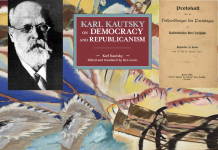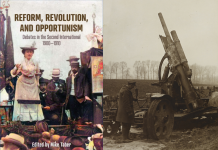Nancy Lindisfarne and Jonathan Neale continue a discussion on their article What gender does, responding to comments from Colin Wilson
To situate our response to Colin, it is useful to see that there are now broadly three schools of approach to gender in rs21. We think it will be healthy for all three approaches to be available in rs21 without one becoming the line. There is much overlap, and over time a synthesis may arise.
One school is ‘intersectional feminism’, which is quite similar to the common socialist feminist approach to linking gender, race and class in the 1970s. The second is the approach we take. The third, which Colin supports, is ‘social reproduction theory’ in the strict sense.
Social reproduction theory in the strict sense is a recent school within Marxism, focused on the central importance of unpaid domestic labour. It began in the 1970s with Marxist feminists like Olivia Harris and Kate Young, and was adapted by Lindsey German and Chris Harman in the International Socialist Tendency in the early 1980s. It does not represent the Marxism of IS before that time, or the various Marxist approaches to gender of Kollontai, Zetkin, Marx, Engels, or Cliff.
However, the meaning of ‘social reproduction’ theory is now changing. At the Historical Materialism Conference in London, October, 2014, people were following the ideas of Sue Ferguson and David McNally. They are using ‘social reproduction’ to mean paying attention to the necessity for any society of reproducing both workers and social relations, through paid and unpaid labour by women and men, and in many other ways. This second meaning seems to us unproblematic, and acceptable to both Marxists and mainstream sociologists.
Colin contrasts our approach with Marxism and with social reproduction theory. We have written at length about our objections to the Harman/German version of social reproduction theory. Rather than repeat those arguments here, it is more interesting to consider the further differences which Colin’s remarks highlight.
Let us treat briefly four differences between us before coming to what we think may be the nub of the debate.
Class and ideology
The first point is about ideology and class inequality. Colin misunderstands our point that class differences are arbitrary and plainly spurious. What we are saying is that, because of the common humanity of rulers and ruled, it is not automatically, nor inevitably, obvious that people currently in the ruling class ought to be there, or indeed that there ought to be a ruling class at all. And because this is so, ruling class use formality, distance and do everything they can to to keep us from seeing that they too eat, shit, fart, fuck and die.
Yet we agree with Colin that very large numbers of people do, more or less, much of the time, accept the inequality of class rule. Our question is why? This is the central question in all Marxist analyses of ideology. Our answer is that accepting gender inequality is a key step to accepting other kinds of ideology.
Everyday embodiment and material needs
Our second point of disagreement stems from Colin’s critique of the notions ‘public’ and ‘private’ as universals. He says we rely on these categories in our analysis. In fact, we have deliberately avoided using these words. Instead, we talk about ‘intimacy’. We write at length about how the structural inequalities of class permeate and infuse the totality of experience in class societies, not just at work, but in every moment of intimacy. Thus, class inequality is with us when we give comfort to each other, when we share food and shelter, when we cuddle a child or make love. We embody class in the food we eat, the warmth of our houses and the clothes we wear. Our size, health and longevity are all marked with class inequality.
Ruling class reconfigurations of gender relations
Third, Colin also usefully focuses on another important difference between us. We think that ruling classes try to control and manage gender to their advantage, and in response to their own changing economic interests.
But we don’t think, as Colin says we do, that the ruling class just make sexism up. We say that they negotiate multiple and varying ideologies of sexism with different publics, and that they are engaged in a constant struggle to mould and change our ideas of gender.
Our paper ‘What Gender Does’ from which Colin is working was published in the ISJ 139. It had a second section available only on the ISJ website. A revised version of the entire paper was later published on the rs21 website. Both papers set out in detail how the ruling class in the US has tried to change popular ideas of gender to fit the new forms of neoliberalism they favoured.
Pressure to get women into waged work, struggles over abortion rights, the medicalization of emotions, and the fight about HIV/Aids are all areas we discuss, tracing the class struggles behind these social changes. Our concern is to see how the ideology and practices are negotiated to realign gender relations with changing political economy. Our more recent, substantial paper, Sexual Violence and Class Inequality traces the ideological struggle over child abuse in the last thirty years. We agree with Colin that this is complex, and that the ruling class never completely get their own way. However, the cover-ups of sexual abuse now being exposed show us clearly that the ruling class do their best to prevail. They are not hegemonic, but they are constantly trying to dominate.
History
Colin highlights another disagreement. He sees the connections between unpaid domestic labour in the family and the needs of capitalists for cheap labour as the key to women’s oppression under capitalism. We are more concerned with a different question: why is there gender inequality in all class societies?
After all, capitalism is only one among dozens or hundreds of forms of class society. Class society has been in existence for about 8,000 years, and capitalism for between 250 and 400 years. And Colin agrees with us that unpaid domestic labour in the family does not explain gender inequality in all class societies. However, he is centrally concerned with capitalism. We think the larger historical question is more interesting. And, we would ask, it is likely there would be one cause of gender inequality in capitalism and a different cause in all other class societies?
When Colin looks back to earlier societies, he turns from domestic labour to the core importance of property. This was Marx and Engel’s position on the causes of gender inequality in all class societies, including capitalism. They went so far as to say that the family was disappearing among workers, because they had no property.
Colin uses this approach to understand feudal society, and to emphasize the importance of chastity in passing on inheritance. The problem is that he is mistaken about the history. The medieval peasant he describes is a fiction, while his feudalism sounds homogenous and British. Moreover, feudalism, however construed, is only one among many forms of class society. Colin seems to accept at face value the rhetoric of chastity and its place in dominant ideologies of class. But the whole of world literature – and social histories of class societies – bear witness to the complex play between the ideals and practices of licit and illicit sex. Very large numbers of subordinate people in most class societies through history have had sex before and outside of marriage as indeed we still do.
Finally
Our approach is entirely materialist, but it is also new, and perhaps surprising. From reading Colin’s response, we sense that there may also be an underlying difference of sentiment between us. The class relations of work are central to our argument, but we also think it is very important to understand the material experience of sex and love.




















